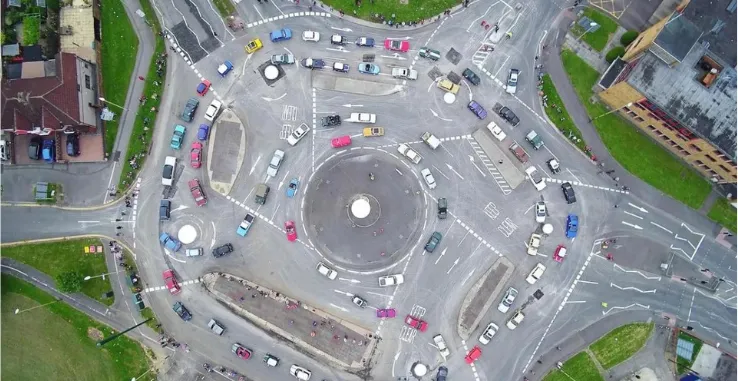The Magic Roundabout in Swindon | How It Became an Icon of Traffic Management

The Magic Roundabout is a remarkable circular junction situated in Swindon, Wiltshire, South West England. It is located close to County Ground and is considered to be one of the most complicated and challenging intersections in the country.
Designed by Frank Blackmore, a traffic engineer at the British Transport and Road Research Laboratory, The Magic Roundabout features five smaller roundabouts arranged in a circle, making it a highly unusual and complex intersection. The traffic flow on the small inner roundabout is counterclockwise, while it is clockwise in the five micro roundabouts and the outer loop.
READ MORE: What’s on in Swindon
Despite being ranked as the fourth-most frightening intersection in Britain by Britannia Rescue, The Magic Roundabout is also considered to be one of the most aesthetically pleasing junctions in the world when viewed from above.
Since its construction in 1972, the overall configuration of The Magic Roundabout has remained largely unchanged. However, during its inauguration, the micro roundabouts were not permanently marked on the ground and could be reconfigured in case the layout was not deemed satisfactory. To manage the traffic flow during this period, police officers were stationed at each gyratory.
Although The Magic Roundabout may appear confusing and challenging to navigate, it remains open to motorists all year round. While there have been 14 serious accidents and approximately 100 recorded in the past 25 years, it is still considered to have a lower accident rate than other similarly busy junctions.
If you are travelling along the M4, Swindon’s Magic Roundabout is definitely worth a visit. It is a fascinating and unique attraction that offers visitors a chance to witness something truly remarkable.
The "magic roundabout" in Swindon, UK pic.twitter.com/8gFys0fwro
— Hostile Design (@hostiledesign) March 6, 2023
Frequently Asked Questions
The Magic Roundabout in Swindon is a unique and innovative traffic management system consisting of five smaller roundabouts arranged in a larger roundabout.
The Magic Roundabout operates on the principle of allowing traffic to flow in multiple directions simultaneously. Vehicles circulate around the central roundabout, choosing the appropriate entry and exit points to reach their desired destinations.
The Magic Roundabout gained its name due to its unconventional design and the complexity it presents to drivers unfamiliar with the system. Its unique arrangement of roundabouts overlapping each other gives it a somewhat “magical” appearance.
The Magic Roundabout in Swindon was built in 1972. It was designed as an experimental traffic management solution to improve traffic flow and reduce congestion in the area.
The Magic Roundabout was designed by the British architect and town planner, Norman Pritchard. His innovative design aimed to address traffic issues by redistributing and managing traffic flow more efficiently.
Yes, the Magic Roundabout has proven effective in improving traffic flow and reducing congestion. Despite its initial skepticism, the system has successfully managed traffic in the Swindon area, providing efficient access to various routes.
The Magic Roundabout can be challenging for drivers unfamiliar with its design. However, with clear signage and proper understanding of the system, navigating it becomes easier. Many drivers and locals have adapted to its unique layout over time.
While accidents can occur at any roundabout or traffic junction, the Magic Roundabout has not experienced a significant increase in accidents compared to traditional intersections. Proper signage and adherence to traffic rules help minimize any potential issues.
Yes, large vehicles such as buses and trucks can navigate the Magic Roundabout. The design of the roundabouts takes into consideration the turning radius required for larger vehicles. However, cautious driving and awareness of other vehicles are essential for safe navigation.
Yes, the Magic Roundabout in Swindon has inspired similar traffic management solutions in other parts of the world. Its success has led to the implementation of similar roundabout systems in various cities, aiming to improve traffic flow and reduce congestion.
